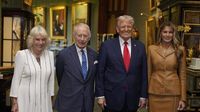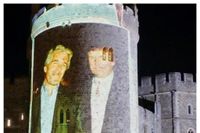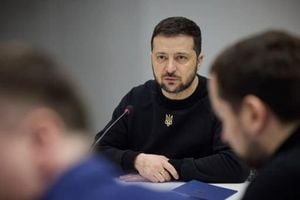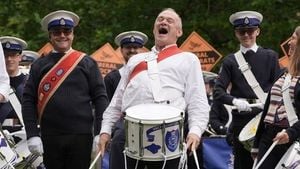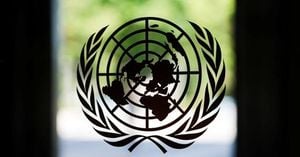When Air Force One touched down at Stansted Airport in Essex on September 16, 2025, all eyes were on the American presidential couple. President Donald Trump and First Lady Melania Trump descended the steps to the tarmac, greeted by a Royal Air Force honor guard and the unmistakable hum of anticipation. Yet it wasn’t just the ceremonial welcome that sparked a flurry of reactions—it was Melania’s rare display of affection, holding hands with her husband as cameras flashed. For a couple known for their often-reserved public demeanor, this small gesture sent the internet into a frenzy. Some online commentators joked, “She’s smiling AND holding his hand. That’s not Melania,” while others speculated about the president’s health after noticing a bruise on his hand. White House spokeswoman Karoline Leavitt quickly addressed the rumors, explaining, “The president has bruises because he works tirelessly and shakes hands all day,” a statement echoed by Trump’s physician, who attributed the marks to a preventive aspirin regimen.
But the spectacle on the tarmac was just the beginning of a whirlwind visit that would blend royal pageantry, high-stakes diplomacy, and controversy. According to BBC and other major outlets, the Trumps were greeted by the Prince and Princess of Wales before joining King Charles III and Queen Camilla for a carriage procession through Windsor’s private grounds. The procession, followed by a lavish state banquet at Windsor Castle, was a nod to the enduring alliance between the United States and the United Kingdom. King Charles III opened the evening with a speech referencing Australia, setting a tone of international camaraderie. The first day’s events were widely hailed as a success, with the royal hosts pulling out all the stops to make the state visit memorable.
Yet, the visit unfolded under an unusual veil of security and secrecy. As reported by Edinburgh News, the state visit was largely held behind closed doors, a departure from the traditional pomp and public parades. British authorities cited concerns about potential unrest and the charged political climate. “It was somewhat laughable to witness a state visit without the usual pomp and carriage parades through the streets. Like watching a football game played in an empty stadium during the Covid pandemic,” quipped columnist Vladimir McTavish. The decision to keep much of the visit private did little to dampen the controversy brewing outside the castle walls.
Days before the Trumps arrived, a group of protesters known as Led By Donkeys projected giant images of Donald Trump with convicted sex offender Jeffrey Epstein onto the exterior of Windsor Castle. The stunt, which quickly went viral on social media, was a pointed critique of the president’s past associations. Thames Valley Police spokesperson Felicity Parker called the act “extremely serious” and confirmed the arrest of four suspects in connection with the projection. The protests were further fueled by the sacking of the UK’s ambassador to the United States, Peter Mandelson, over his own ties to Epstein. As PA Images and other outlets reported, the juxtaposition of Mandelson’s dismissal and Trump’s red-carpet welcome did not go unnoticed by the British public, who responded with a mix of sarcasm, outrage, and humor online.
Despite the tense backdrop, the official itinerary pressed forward. On September 18, King Charles III and Queen Camilla formally bid farewell to the Trumps at Windsor Castle, marking the end of the state visit’s second day. But before departing, President Trump met with British Prime Minister Keir Starmer at the leader’s country home for what would become the visit’s most consequential moment. Emerging from their meeting, the two leaders announced a sweeping $350 billion “Tech Prosperity Deal” aimed at boosting cooperation between the US and UK in quantum computing and artificial intelligence. The deal, hailed as a major economic and technological milestone, also included plans to bolster the deployment of new nuclear power stations in both countries. British leaders, who had been anxious about the optics and potential flashpoints of the visit, declared the summit a success.
According to Sipa USA and other sources, the leaders also addressed thorny foreign policy issues. Reporters pressed President Trump about the UK’s consideration of recognizing a Palestinian state—an issue where he and Prime Minister Starmer did not see eye to eye. “I have a disagreement with the Prime Minister on that score, one of our few disagreements actually,” Trump told the assembled press, deftly sidestepping a potential diplomatic rift. British officials had braced for sharper clashes on foreign policy, but the leaders managed to keep their differences largely behind closed doors, focusing instead on shared economic and technological ambitions.
For the British government, the visit was as much about optics as substance. With the specter of protests and the recent ambassador scandal looming, officials were determined to keep President Trump away from demonstrators and maintain a tightly controlled environment. Their efforts paid off—at least in terms of public order—even as the internet buzzed with memes and debates about the visit’s meaning.
The state banquet itself was a study in diplomatic theater. Attendees described a sumptuous affair, with warm words exchanged between the royals and the American delegation. According to BBC, King Charles III’s speech set a tone of unity, while President Trump’s remarks focused on the enduring partnership between the two nations. The event was attended by key figures from both governments, as well as business leaders eager to capitalize on the new tech deals.
Still, the shadow of controversy was never far. The projection of Trump’s image alongside Epstein continued to dominate headlines, and the arrests of four protesters became a rallying point for critics of the president and his British hosts. Social media users seized on the moment, with some questioning the wisdom of rolling out the red carpet for a leader dogged by scandal. Others, however, saw the visit as a necessary affirmation of the transatlantic alliance, emphasizing the importance of economic cooperation in an era of global uncertainty.
As the Trumps boarded their helicopter to depart Windsor, the legacy of the visit remained an open question. Was it a triumph of diplomacy and tradition, or a carefully managed spectacle overshadowed by controversy? For many, the answer lay somewhere in between—a reminder that in today’s political climate, even the grandest gestures are subject to scrutiny, satire, and spirited debate.
In the end, Britain’s welcome for President Trump was as complex as the man himself: a blend of pageantry and pragmatism, celebration and controversy, all set against the storied backdrop of Windsor Castle.
